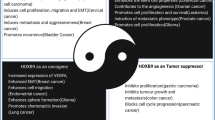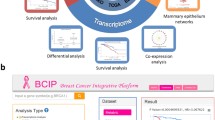Abstract
Background
The homeobox (HOX) family consists of 39 genes whose expressions are tightly controlled and coordinated within the family, during development. We performed a comprehensive analysis of this gene family in cancer settings.
Methods
Gene correlation analysis was performed using breast cancer data available in The Cancer Genome Atlas (TCGA) and data from the patients admitted to our hospital. We also analyzed the data of normal breast tissue (GSE20437). We next collected gene expression and prognosis data of breast cancer patients (GSE11121, GSE7390, GSE3494, and GSE2990) and performed unsupervised hierarchal clustering by the HOX gene expression pattern and compared prognosis. We additionally performed this analysis to leukemia (available in TCGA) and sarcoma (GSE20196) data.
Results
Gene correlation analysis showed that the proximal HOX genes exhibit strong interactions and are expressed together in breast cancer, similar to the expression observed during development. However, in normal breast tissue, less interactions were observed. Breast cancer microarray meta-data classified by the HOX gene expression pattern predicted the prognosis of luminal B breast cancer patients (p = 0.016). Leukemia (p = 0.00016) and sarcoma (p = 0.018) presented similar results. The Wnt signaling pathway, one of the major upstream signals of HOX genes in development, was activated in the poor prognostic group. Interestingly, poor prognostic cancer presented stronger correlation in the gene family compared to favorable prognostic cancer.
Conclusion
Comprehensive analysis of the HOX family demonstrated their similar roles in cancer and development, and indicated that the strong interaction of HOX genes might be specific to malignancies, especially in the case of poor prognostic cancer.



Similar content being viewed by others
Data availability
The datasets generated during and/or analysed during the current study are available from the corresponding author on reasonable request.
References
Shah N, Sukumar S (2010) The Hox genes and their roles in oncogenesis. Nat Rev Cancer 10:361–371. https://doi.org/10.1038/nrc2826
Wellik DM (2009) Hox genes and vertebrate axial pattern. Current topics in developmental biology. Elsevier, Amsterdam, pp 257–278
Deschamps J, Duboule D (2017) Embryonic timing, axial stem cells, chromatin dynamics, and the Hox clock. Genes Dev 31:1406–1416. https://doi.org/10.1101/gad.303123.117
Rux DR, Wellik DM (2017) Hox genes in the adult skeleton: novel functions beyond embryonic development. Dev Dyn 246:310–317. https://doi.org/10.1002/dvdy.24482
de Bessa Garcia SA, Araújo M, Pereira T et al (2020) HOX genes function in breast cancer development. Biochim Biophys Acta - Rev Cancer. https://doi.org/10.1016/j.bbcan.2020.188358
Huang D, Guo G, Yuan P et al (2017) The role of Cdx2 as a lineage specific transcriptional repressor for pluripotent network during the first developmental cell lineage segregation. Sci Rep 7:17156. https://doi.org/10.1038/s41598-017-16009-w
Rawat VPS, Thoene S, Naidu VM et al (2008) Overexpression of CDX2 perturbs HOX gene expression in murine progenitors depending on its N-terminal domain and is closely correlated with deregulated HOX gene expression in human acute myeloid leukemia. Blood. https://doi.org/10.1182/blood-2007-04
Neijts R, Amin S, van Rooijen C, Deschamps J (2017) Cdx is crucial for the timing mechanism driving colinear Hox activation and defines a trunk segment in the Hox cluster topology. Dev Biol 422:146–154. https://doi.org/10.1016/j.ydbio.2016.12.024
Young T, Elizabeth Rowland J, van de Ven C et al (2009) Cdx and Hox genes differentially regulate posterior axial growth in mammalian embryos. Dev Cell 17:516–526. https://doi.org/10.1016/j.devcel.2009.08.010
Denans N, Iimura T, Pourquié O (2015) Hox genes control vertebrate body elongation by collinear Wnt repression. Elife. https://doi.org/10.7554/eLife.04379
Soshnikova N, Duboule D (2009) Epigenetic temporal control of mouse Hox genes in vivo. Science 324:1320–1323. https://doi.org/10.1126/science.1171468
Jambhekar A, Dhall A, Shi Y (2019) Roles and regulation of histone methylation in animal development. Nat Rev Mol Cell Biol 20:625–641. https://doi.org/10.1038/s41580-019-0151-1
Noordermeer D, Leleu M, Splinter E et al (2011) The dynamic architecture of Hox gene clusters. Science 334:222–225. https://doi.org/10.1126/science.1207194
De Kumar B, Krumlauf R (2016) HOX s and lincRNAs: two sides of the same coin. Sci Adv 2:e1501402. https://doi.org/10.1126/sciadv.1501402
Botti G, De Chiara A, Di Bonito M et al (2019) Noncoding RNAs within the HOX gene network in tumor pathogenesis and progression. J Cell Physiol 234:395–413. https://doi.org/10.1002/jcp.27036
Bhatlekar S, Fields JZ, Boman BM (2014) HOX genes and their role in the development of human cancers. J Mol Med 92:811–823. https://doi.org/10.1007/s00109-014-1181-y
Jin K, Sukumar S (2016) HOX genes: major actors in resistance to selective endocrine response modifiers. Biochim Biophys Acta - Rev Cancer 1865:105–110. https://doi.org/10.1016/j.bbcan.2016.01.003
Wang J, Chen J, Wang Y (2015) Prognostic role of HOTAIR in four estrogen- dependent malignant tumors: a meta-analysis. Onco Targets Ther. https://doi.org/10.2147/OTT.S84687
Shah N, Jin K, Cruz LA et al (2013) HOXB13 mediates tamoxifen resistance and invasiveness in human breast cancer by suppressing ERα and inducing IL-6 expression. Cancer Res 73:5449–5458. https://doi.org/10.1158/0008-5472.CAN-13-1178
Zhong Z, Shan M, Wang J et al (2015) HOXD13 methylation status is a prognostic indicator in breast cancer. Int J Clin Exp Pathol 8:10716–10724
Hayashida T, Takahashi F, Chiba N et al (2010) HOXB9, a gene overexpressed in breast cancer, promotes tumorigenicity and lung metastasis. Proc Natl Acad Sci USA 107:1100–1105. https://doi.org/10.1073/pnas.0912710107
Zhussupova A, Hayashida T, Takahashi M et al (2014) An E2F1-HOXB9 transcriptional circuit is associated with breast cancer progression. PLoS ONE 9:1–11. https://doi.org/10.1371/journal.pone.0105285
Carrio M, Arderiu G, Myers C, Boudreau NJ (2005) Homeobox D10 induces phenotypic reversion of breast tumor cells in a three-dimensional culture model. Cancer Res 65:7177–7185. https://doi.org/10.1158/0008-5472.CAN-04-1717
Nakashoji A, Hayashida T, Kawai Y et al (2020) Identification of a modified HOXB9 mRNA in breast cancer. J Oncol. https://doi.org/10.1155/2020/6065736
Nolte C, Jinks T, Wang X et al (2013) Shadow enhancers flanking the HoxB cluster direct dynamic Hox expression in early heart and endoderm development. Dev Biol 383:158–173. https://doi.org/10.1016/J.YDBIO.2013.09.016
Neijts R, Deschamps J (2017) At the base of colinear Hox gene expression: cis -features and trans -factors orchestrating the initial phase of Hox cluster activation. Dev Biol 428:293–299. https://doi.org/10.1016/j.ydbio.2017.02.009
Deschamps J, van Nes J (2005) Developmental regulation of the Hox genes during axial morphogenesis in the mouse. Development 132:2931–2942. https://doi.org/10.1242/DEV.01897
Ordóñez-Morán P, Dafflon C, Imajo M et al (2015) HOXA5 counteracts stem cell traits by inhibiting Wnt signaling in colorectal cancer. Cancer Cell 28:815–829. https://doi.org/10.1016/j.ccell.2015.11.001
Nguyen DX, Chiang AC, Zhang XHF et al (2009) WNT/TCF signaling through LEF1 and HOXB9 mediates lung adenocarcinoma metastasis. Cell 138:51–62. https://doi.org/10.1016/j.cell.2009.04.030
Paço A, de Bessa Garcia SA, Freitas R (2020) Methylation in HOX clusters and its applications in cancer therapy. Cells 9:1–20. https://doi.org/10.3390/cells9071613
Marcinkiewicz KM, Gudas LJ (2014) Altered histone mark deposition and DNA methylation at homeobox genes in human oral squamous cell carcinoma. J Cell Physiol 229:1405–1416. https://doi.org/10.1002/jcp.24577
Collins CT, Hess JL (2016) Role of HOXA9 in leukemia: dysregulation, cofactors and essential targets. Oncogene 35:1090–1098. https://doi.org/10.1038/onc.2015.174
Manzo G (2019) Similarities between embryo development and cancer process suggest new strategies for research and therapy of tumors: a new point of view. Front Cell Dev Biol 7:20. https://doi.org/10.3389/fcell.2019.00020
Cofre J, Abdelhay E (2017) Cancer is to embryology as mutation is to genetics: hypothesis of the cancer as embryological phenomenon. Sci World J 2017:3578090. https://doi.org/10.1155/2017/3578090
Ben-David U, Benvenisty N (2011) The tumorigenicity of human embryonic and induced pluripotent stem cells. Nat Rev Cancer 11:268–277. https://doi.org/10.1038/nrc3034
Acknowledgements
The authors greatly thank Mr. Kazuya Takakuwa for help in bioinformatics analysis. They also thank Mr. Kazuhiro Miyao for scientific advice.
Funding
This work was supported by Japan Society for the Promotion of Science (Grant Number 19K23897).
Author information
Authors and Affiliations
Corresponding author
Ethics declarations
Conflict of interest
The authors declare that there is no conflict of interest regarding the publication of this paper.
Ethical approval
All procedures performed in studies involving human participants were in accordance with the ethical standards of the institutional and/or national research committee and with the 1964 Helsinki declaration and its later amendments or comparable ethical standards.
Informed consent
Informed consent was obtained from all individual participants included in the study.
Additional information
Publisher's Note
Springer Nature remains neutral with regard to jurisdictional claims in published maps and institutional affiliations.
Supplementary Information
Below is the link to the electronic supplementary material.
Rights and permissions
About this article
Cite this article
Nakashoji, A., Hayashida, T., Yamaguchi, S. et al. Comprehensive analysis of the homeobox family genes in breast cancer demonstrates their similar roles in cancer and development. Breast Cancer Res Treat 186, 353–361 (2021). https://doi.org/10.1007/s10549-020-06087-2
Received:
Accepted:
Published:
Issue Date:
DOI: https://doi.org/10.1007/s10549-020-06087-2




